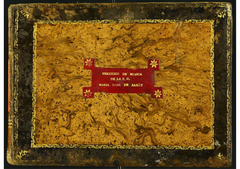The First Record from Andorra in RISM: The “Periodico de musica” of Maria Rosa d’Areny Jordana
Joan Benavent Peiró
Monday, June 15, 2020

We have received the following from Joan Benavent Peiró, PhD student in musicology at University of Andorra.
The Principality of Andorra has recently been incorporated into the RISM database with the cataloging of “El Periódico de música de la S. D. Maria Rosa de Areny” (RISM ID no.: 1001050169). The discovery of the new documentary source expands our knowledge of musical keyboard notebooks played in private gatherings, a reflection of the musical practices of wealthy families around 1820.
The volume, preserved today at the Biblioteca Nacional d’Andorra (RISM library siglum: AND-AVbn) but originally kept at the Casa Museu Areny-Plandolit d’Ordino in Ordino, is a miscellaneous volume with a total of 104 popular Catalonian compositions arranged mostly for pianoforte and dates from the beginning of the nineteenth century.
The manuscript contains a variety of pieces including those from religious genres, the oral tradition such as the popular Catalan song La Bolangera, as well as dances, minuets and contradances, mostly anonymous. It also features compositions by Ignace Joseph Pleyel, Francisco Antonio Yanguas and Thomas Bremond. Pieces such as symphonies by Carles Baguer and a Funeral March by the composer Rafael Compta, among other composers, are grouped in this genre.
The Ariana symphony in the manuscript (RISM ID no.: 1001051682) deserves special attention. The piece, attributed in the document to Vincenzo Pucitta, matches different copies located in other Catalan archives. However, when comparing the musical incipit in the RISM database, the piece matches a manuscript from the Civica Biblioteca Archivi storici Angelo Mai in Bergamo, but authored by Johann Simon Mayr (ID no.: 850006138). Is it plagiarism between authors or are they just pieces with the same beginning? Is Pucitta or Mayr its first creator? Everything points to the fact that the piece is originally by Mayr and confusion in the Catalan geographical area is due to an error by the first copyist that was repeated in the rest of the manuscripts. Unfortunately, we do not have the answer, and the record keeps Pucitta as the composer, in line of the copies existing in the Catalan and Andorran archives. However, the correlation with Mayr has been detailed in the record for the piece.
The other genre to highlight in the manuscript is opera. The reductions for keyboard and, in some cases, for voice of popular Italian operas in Barcelona in the 1800s are the result of adaptations of the introductory symphonies and different fragments of the most popular parts of the compositions. Operas in the manuscript include Pietro Generali’s La contessa di colle erboso, Domenico Cimarosa’s Le trame deluse, and Innocente fortunata by Giovanni Paisiello, which in the manuscript appears with the title La máscara Real (ID no.: 1001051681). It is worth mentioning that he composer wrote different versions of this last piece and that the symphony of the Andorran piece matches the opening of version 3 of those cataloged by Michael Robinson, which is identical to a composition in I-Rmassimo (ID no.: 858000171). In addition to these operas, the volume features La donna selvaggia by Carlo Coccia and La gazza ladra, Otello and Tancredi by Gioacchino Rossini.
In summary, the Andorran musical source collects different pieces that were in vogue at the time and brings together, apart from religious pieces, dances and themes from popular traditions, reductions of orchestral symphonies and different operas, mostly orchestral, for piano. They are compositions that were compiled for private performances by its owner in Andorra around 1820.
The cataloging of the manuscript was carried out thanks to a research grant from the Government of Andorra (AM058-AND-2017). From this work the article “El periòdic musical de Maria Rosa d’Areny i Jordana de la Casa Museu d’Areny Plandolit d’Andorra” was published by the Societat Andorrana de ciències, and included the results of the research in the R + D + I project (HAR2017-86039-C2-1-P) El patrimonio musical de la España moderna (siglos XVII-XVIII): recuperación, digitalización, análisis, recepción y estructuras retóricas de los discursos musicales, directed by Antonio Ezquerro.
Image: Arxiu Nacional d’Andorra – Biblioteca Nacional d’Andorra. Cover, AND-AVbn ACAP.LP.154. RISM ID no. 001050169. Courtesy of the author.
Share Tweet EmailCategory: New at RISM

